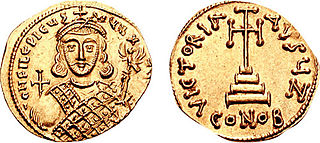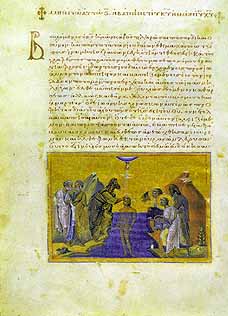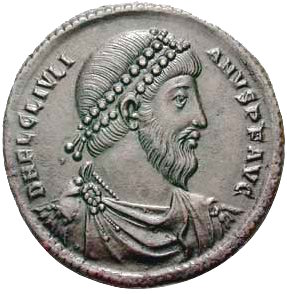
Philippikos or Philippicus was Emperor of the Byzantine Empire from 711 to 713.

Michael III was Byzantine Emperor from 842 to 867. Michael III was the third and traditionally last member of the Amorian dynasty. He was given the disparaging epithet the Drunkard by the hostile historians of the succeeding Macedonian dynasty, but modern historical research has rehabilitated his reputation to some extent, demonstrating the vital role his reign played in the resurgence of Byzantine power in the 9th century.

Byzantine art refers to the body of Christian Greek artistic products of the Eastern Roman (Byzantine) Empire, as well as the nations and states that inherited culturally from the empire. Though the empire itself emerged from the decline of Rome and lasted until the Fall of Constantinople in 1453, the start date of the Byzantine period is rather clearer in art history than in political history, if still imprecise. Many Eastern Orthodox states in Eastern Europe, as well as to some degree the Muslim states of the eastern Mediterranean, preserved many aspects of the empire's culture and art for centuries afterward.

For the third copy of the Utrecht Psalter. produced in England in the late 12th century, see Great Canterbury Psalter. Paris, Bibliothèque Nationale
Lazarus Zographos is a 9th- century Byzantine Christian saint. He is also known as Lazarus the Painter and Lazarus the Iconographer. Born in Armenia on November 17, 810, he lived before and during the second period of Byzantine Iconoclasm. Lazarus is the first saint to be canonized specifically as an iconographer. He was later followed by Saint Catherine of Bologna, Theodore the Studite and Saint Luke the Evangelist, all of whom were painters of Icons.

St. Ignatius or Ignatios, was a Patriarch of Constantinople from July 4, 847, to October 23, 858, and from November 23, 867, to his death on October 23, 877. In the Roman Catholic and Eastern Orthodox Churches, he is regarded as a saint, with a feast day of October 23.
Antony IKassymatas, Ecumenical Patriarch of Constantinople from January 821 to January 837.

Byzantine Iconoclasm refers to two periods in the history of the Byzantine Empire when the use of religious images or icons was opposed by religious and imperial authorities within the Eastern Church and the temporal imperial hierarchy. The "First Iconoclasm", as it is sometimes called, existed between about 726 and 787. The "Second Iconoclasm" was between 814 and 842. According to the traditional view, Byzantine Iconoclasm was started by a ban on religious images by Emperor Leo III and continued under his successors. It was accompanied by widespread destruction of images and persecution of supporters of the veneration of images. The Western church remained firmly in support of the use of images throughout the period, and the whole episode widened the growing divergence between the Eastern and Western traditions in what was still a unified church, as well as facilitating the reduction or removal of Byzantine political control over parts of Italy.

The Three Hierarchs of Eastern Christianity refers to Basil the Great, Gregory the Theologian and John Chrysostom. They were highly influential bishops of the early church who played pivotal roles in shaping Christian theology. In Eastern Christianity they are also known as the Three Great Hierarchs and Ecumenical Teachers, while in Roman Catholicism the three are honored as Doctors of the Church. The three are venerated as saints in Eastern Orthodoxy, Catholicism, Anglicanism, and other Christian churches.

Byzantine science played an important role in the transmission of classical knowledge to the Islamic world and to Renaissance Italy, and also in the transmission of Islamic science to Renaissance Italy. Its rich historiographical tradition preserved ancient knowledge upon which splendid art, architecture, literature and technological achievements were built.

Byzantine studies is an interdisciplinary branch of the humanities that addresses the history, culture, demography, dress, religion/theology, art, literature/epigraphy, music, science, economy, coinage and politics of the Eastern Roman Empire. The discipline's founder in Germany is considered to be the philologist Hieronymus Wolf (1516-1580), a Renaissance Humanist. He gave the name "Byzantine" to the Eastern Roman Empire that continued after the Western Roman Empire collapsed in 476 AD. About 100 years after the final conquest of Byzantium by the Ottomans, Wolf began to collect, edit, and translate the writings of Byzantine philosophers. Other 16th-century humanists introduced Byzantine studies to Holland and Italy. The subject may also be called Byzantinology or Byzantology, although these terms are usually found in English translations of original non-English sources. A scholar of Byzantine studies is called a Byzantinist.

Alexios Stoudites or Alexius Studites, an Ecumenical Patriarch of Constantinople, was a member of the Monastery of Stoudios, succeeded Eustathius of Constantinople as Patriarch in 1025, the last of the Patriarchs appointed by the Emperor Basil II.
Leo the Mathematician or the Philosopher was a Byzantine philosopher and logician associated with the Macedonian Renaissance and the end of the Second Byzantine Iconoclasm. His only preserved writings are some notes contained in manuscripts of Plato's dialogues. He has been called a "true Renaissance man" and "the cleverest man in Byzantium in the 9th century". He was archbishop of Thessalonica and later became the head of the Magnaura School of philosophy in Constantinople, where he taught Aristotelian logic.
The prōtasēkrētis, also found as prōtoasēkrētis (πρωτοασηκρῆτις) and Latinized as protasecretis or protoasecretis, was a senior official in the Byzantine bureaucracy. The title means "first asēkrētis", illustrating his position as the head of the order of the asēkrētis, the senior class of imperial notaries.

The Menologion of Basil II is an illuminated manuscript designed as a church calendar or Eastern Orthodox Church service book (menologion) that was compiled c. 1000 AD, for the Byzantine Emperor Basil II. It contains a synaxarion, a short collection of saints' lives, compiled at Constantinople for liturgical use, and around 430 miniature paintings by eight different artists. It was unusual for a menologion from that era to be so richly painted. It currently resides in the Vatican Library . A full facsimile was produced in 1907.
Sergios Niketiates was a senior Byzantine official and member of the Amorian dynasty. He is celebrated as a saint by the Orthodox Church on 28 June for his role in the restoration of the veneration of icons.
Leslie Brubaker is an expert in Byzantine illustrated manuscripts and was appointed the Professor of Byzantine Art at the University of Birmingham in 2005. Her research interests includes female patronage, icons and the cult of the Virgin Mary. She was formerly the head of Postgraduate Studies in the College of Arts and Law, University of Birmingham. Professor Brubaker is also on the Executive Committee of the Society for the Promotion of Byzantine Studies. Her work is widely stocked in libraries around the world.

The Byzantine Empire was ruled by the Amorian or Phrygiandynasty from 820 to 867. The Amorian dynasty continued the policy of restored iconoclasm started by the previous non-dynastic emperor Leo V in 813, until its abolishment by Empress Theodora with the help of Patriarch Methodios in 842. The continued iconoclasm further worsened relations between the East and the West, which were already bad following the papal coronations of a rival line of "Roman Emperors" beginning with Charlemagne in 800. Relations worsened even further during the so-called Photian Schism, when Pope Nicholas I challenged Photios' elevation to the patriarchate.
The Council of Constantinople of 861, also known as Protodeutera, was a major Church Council, convened upon the initiative of Emperor Michael III of Byzantium and Patriarch Photios I of Constantinople, and attended by legates of Pope Nicholas I. The Council confirmed the deposition of former Patriarch Ignatius of Constantinople, and his replacement by Photios. Several dogmatic, ecclesiological and liturgical questions were also discussed, and seventeen canons were produced. Decisions of the Council were initially approved by papal legates, but their approval was later annulled by the Pope. In spite of that, the Council is considered as valid by the Eastern Orthodox Church.














